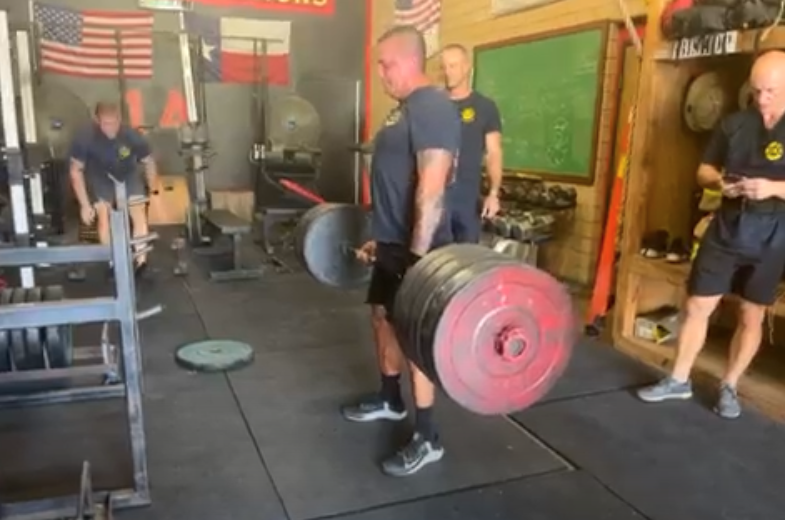
BLUF
This Mini Study sought to give a snapshot and comparison of the relative strength and work capacity of three types of Tactical Athletes and civilians.
The results found that for the athletes tested, Urban Fire Athletes scored higher overall in relative strength than State SWAT/SRT, Federal SWAT/SRT and civilian athletes. Five of the six Urban Fire athletes tested scored “Excellent” in the MTI Relative Strength Assessment.
The types of tactical athletes scored much closer in Work Capacity, with the Federal SWAT/SRT athletes coming away with the highest overall average score. All six of the Federal SWAT/SRT athletes scored “good” in the MTI Tactical Athlete Work Capacity Assessment.
Background and Study Design
The four groups of athletes in this Mini Study each completed 4 weeks of MTI’s Daily Base Fitness Programming for their respective athlete type prior to taking the two assessments. Specifically, the State and Federal SWAT/SRT athletes completed the same 4 weeks of base fitness programming prior to taking the assessments. The Urban Fire and Civilian athletes each completed a different 4-week base fitness cycle.
Importantly, none of the athletes trained specifically for these assessments prior to taking them.
Below are the assessment details:
MTI Relative Strength Assessment
Warm Up:
(1) 3 Rounds
Barbell Complex @ 45/65#
Instep Stretch
Lat + Pec Stretch
(2) Get on a scale and weigh yourself
Training:
(1) Work up to 1RM Front Squat (1RM = 1 Repetition Maximum)
(2) Max Rep Strict Pull Ups (no kipping, bucking, jerking, etc.)
(3) Work up to 1RM Hinge Lift
(4) Work up to 1RM Bench Press
Record 1RM’s, max pull ups reps, and Bodyweight.
Scoring:
Add together your finishing loads for front squat, hinge lift and bench press.
For pulling strength, multiply your max rep pull up times 10% of your bodyweight.
For example, if you weigh 200 pounds, and get 12 pull ups, you’d multiply 10% of 200 (200 x .1 = 20) and 12.
20×12 = 240.
** Note on Pull Ups … the Max Number you can use for scoring for this assessment is 20. So even if you tested at 25x pullups, the most you can use for your scoring is 20.
Add your pulling strength total to your other 1RM’s, and divide by your bodyweight. The final number is your score.
SCORING EXAMPLE #1:
Male Army Infantryman ….
-
-
-
- Bodyweight – 201 lb
- 1RM Front Squat – 275 lb
- 1RM Bench Press – 275 lb
- 1RM Hinge Lift – 435 lb
- Max Rep Pull Ups – 22
-
-
Pull up scoring maxes out at 20 reps. So, 10% of Bodyweight x 20 Reps … 201 x .10 = 20.1 x 20 pull up reps = 402
275 – Front Squat 1RM
275 – Bench Press 1RM
435 – Hinge Lift 1RM
402 – Pull Up Score
1,387 / 201 (bodyweight) = 6.9, or “Excellent” for Tactical Athletes.
MTI Tactical Athlete Work Capacity Assessment
Uniform: PT Gear
Load:25# weight vest, IBA or Ruck
Warm Up:
4 Rounds (unloaded)
-
-
- 5x Push Ups
- 5x Walking Lunges
- Run 25m
- Instep Stretch
-
Assessment wearing 25# weight vest, IBA or Ruck
-
-
- 3 Minutes 25m shuttle sprints for reps – with a drop to prone at each end
- Rest 1 minute
- 3 Minutes 25m shuttle sprints for reps – with a drop to prone at each end
- Rest 1 minute
- 3 Minutes 25m shuttle sprints for reps – with a drop to prone at each end
-
1x Rep = 1x 25m length, so a round trip = 2x Reps. Only full lengths count. The athlete starts on the ground prone and must drop to the ground prone at each turnaround.
Tally the total reps for each round. A sum of reps from all 3 rounds is the athlete’s final score.
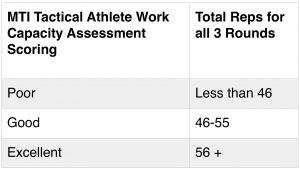
Results & Discussion
Below are the individual scores for each set of athletes:
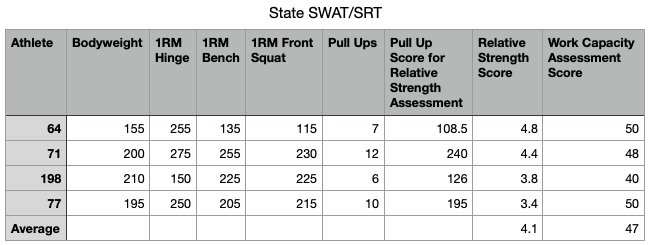
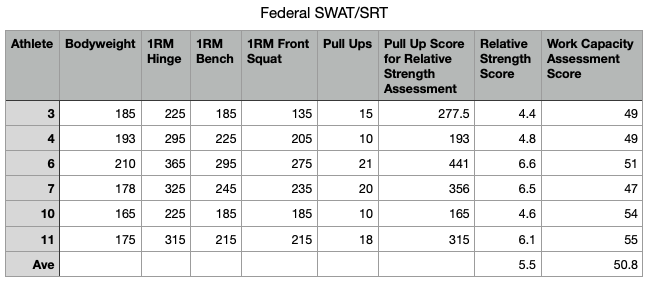
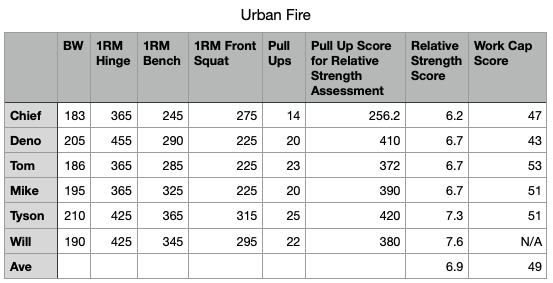
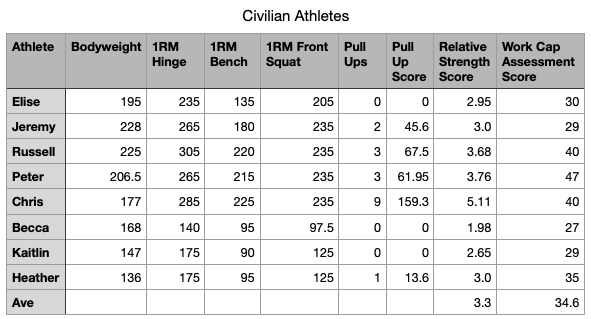
Below are how many athletes, by athlete type, scored “poor,” “good” or “excellent” for each assessment:
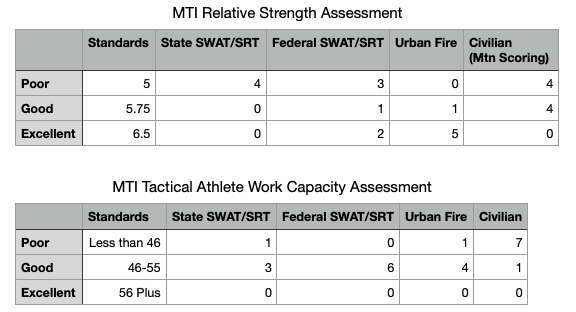
Here are the Average Scores by Athlete Type:

Overall, I was surprised and impressed by the performance of the Urban Fire athletes in this Mini Study …. especially the relative strength assessment score. Both the State and Federal SWAT/SRT athlete teams in this mini-study are full time teams, and the average score for each team rates as “poor” based on MTI’s relative strength standards.
From a programming perspective, if I was programming specially for these SWAT/SRT teams, the next cycle would have a strong strength focus. No group of athletes excelled on the Work Capacity Assessment – but each did score “good” on average.
The Civilian Athletes in this mini study scored far behind the tactical athletes, on average, but these specific athletes have only been completing MTI-specific programming for 4 weeks, and unlike law enforcement and urban fire personnel, they are not professional athletes.
We’d hoped to have one to two sets of military athletes also complete these assessments, but those plans fell through and their absence is disappointing.
Next Steps
We’ve done these “snapshot” assessments in the past and they help validate MTI’s assessment design, and base fitness programming. As well as indicate to us how to “tweak” our base fitness programming to address shortcomings. What we didn’t do this time was an endurance assessment as well. MTI has an established endurance assessment for military athletes, but none for LE SWAT/SRT or Urban Fire. This suggests there’s work there to do.
Questions? Email rob@mtntactical.com
Comments? Please enter your comment below.
